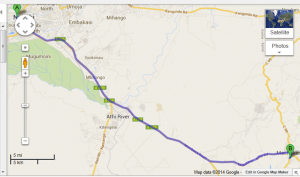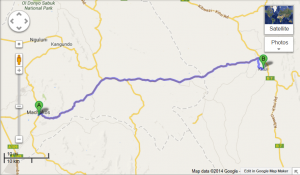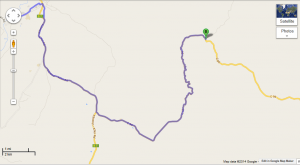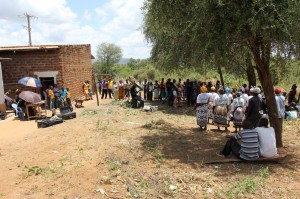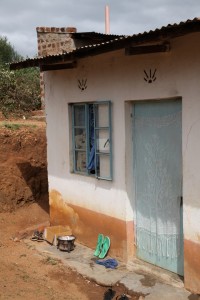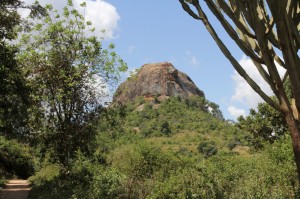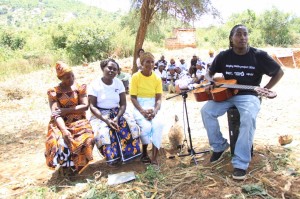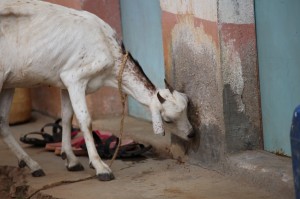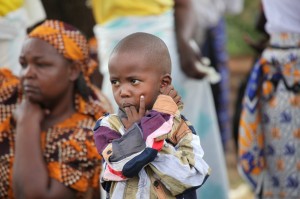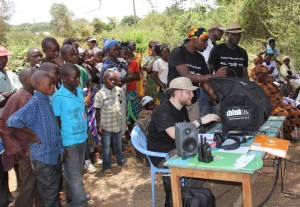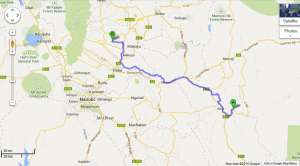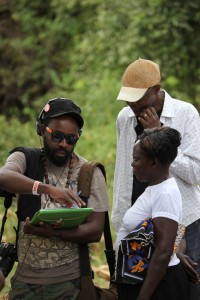We all met at the Fairview at 5:30 AM, packed and departed at 6:00AM, travelling from Nairobi to Kitui, on the Mombasa Road, arriving at 10:00AM. We picked up our local contact, Dominic Mukora, and drove to the Kiongwe Market to record our first group. Here’s our route:
The site passed the first Singing Wells test, lots of chickens and children; we find their noises the perfect backing track for all our recordings.
The market structures were beautiful with the typical brick structure, light blue paint and the red earth of Africa bleeding up the walls.
The market itself was nestled below a lovely hill of green, which stood 500 meters above us, stuck into the blue skies.
We were here to record 4 separate women groups of the Kamba ethnic community, from the same villiage of Kiongwe, each of which would do 3-4 performances. Most of the groups performed with a Ileve (tin shaker) and Vilingi (tin whistle). The final group also introduced us to the Kilumi (drums).
The Music Groups
Twone Mbee
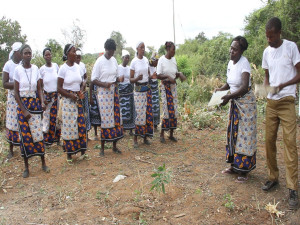
The group is led by Christine Kisove, using the Itheke dance styles (Mwen-yenyo, Mutundo). The group is part of the Kamba ethnic community (Ukama wa Kitui), from the village of Kiongwe, Ngungi Sub-Location, Thua Location, Nzambani District. They performed three songs:
- Asyai: they use the Ileve (Tin Shaker) and Vilingi (Whistle). David Kithome performed with the shaker and Christine Kisove and Eliza Musyoka played the whistles. The song encourages parents to invest in education because that is the key to success.
- Mwaki (means fire). This is a political song praising a prospective parliamentarian. It discourages other prospective candidates from attempting the position because it is already taken by the one they are praising.
- Nzembanie na ivinda (Chasing After Time). This song talks about the President’s call to stop corruption. The call to chase after time comes from the society that won’t condone these malpractices.
Kaniini Kaseo
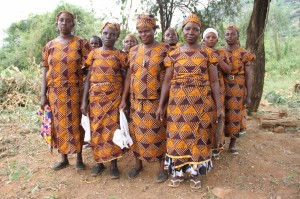
The group is led by Mumbi Wambua, in Kyolo style. The group is also from Kamba ethnic community (ukambani wa kitui) and also from the village of Kiongwe. They have 16 members and were formed in 1980. They performed 3 songs, all of which use the Ileve (tin shaker, played by Mumbi Wambua) and Vilingi (whistle):
- Mutambo wa iiu: This means the trunk of a banana tree; it says that the trunk can’t be climbed by boys.
- Mutongoi: This is a song sung to a political leader in the area. The song praises the politician and asks the people to vote for him – he’s Kyonekana na nengwe. His name means, “if seen give it to him”.
- Kolleji or College: This is sung in the Itheke genre. The song praises a local politician (Major Mutina Muluvi) who takes graduate students to work at Equity Bank and high school leavers to college if their parents can’t afford it.
Wendo
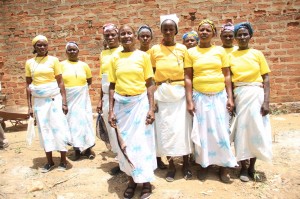
Also from the Kamba ethnic community (Ukamba wa kitui) and led by Kasuku Kioko, Kamba. They perform in the Kasanga dance style. The group is also from the Kiongwe Village, Ngungi Location, Thua Division, Inuu Sub Location, Nzambani District. 12 women and 2 men, formed in the 80’s and inspired to perform at political forum. The group also uses the Vilingi (whistle). They performed 4 songs:
- Kiuluni
- Kui Landeni (going to London)
- Mbovoi
- Kisanga
Kumbaka Asee
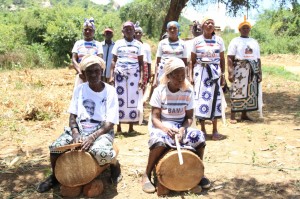
The group is led by Margaret Mbia and plays in the musical style of Kilumi, wathi wa kikamba. They are also from the Kamba ethnic community (ukamba wa kitui). They have 15 members and are inspired by kithio kya mukambu (Kamba tradition). They were formed in 1974. They use two drums called Kilumi, played by Makai King’ei and Koka Mbindyo. They played two songs:
At the end of the session, Ralph worked with three of the group leads on an influences song.
A view more scenes from the Kiongwe Market:
From the Kiongwe Market, we packed up and drove four more hours from Kitui to Kiongwe to Muranga on the Thika road, arriving at the Nokras Hotel in Muranga at about 1800. Here’s the route:
We were all pretty shattered, so had a quick dinner (only quick if you ordered fish or meat, the chickens were apparently hard to catch and took considerably longer), drank the mandatory round of Tuskers and slipped off to bed.
Working Practices: Roles and Responsibilities of the Team
Each day, we will also bring you a set of ‘working practices’ we have been using at Singing Wells and that we hope will be useful to others setting up a similar project. Today we focus on roles/responsibilities of the core team.
On arrival at the site, we divide into three teams:
Interview Team
This team is typically Tabu Osusa, who acts as the on-site Singing Wells representative, formally meeting the band and handling all their questions about the project and their role in it. Tabu is typically joined by our local music expert, in this case Gregg, who took the lead in interviews. Gregg has a worksheet prepared in advance that he uses to capture information on the group, their songs, and their unique instruments or musical styles. Here he is with Christine Kosove of Twone Mbee.
Audio Team
This team always includes two sound engineers, one of whom sets up the mixing station (in this case Andy) and the other that sets up the microphones (in this case Steve). They are assisted by ‘all hands’ for the set up and break down of the session, as the audio equipment is the most extensive. Also assigned to the audio team is “Mr. Clapperboard” (Audio 3, in this case, Nick) who handles the clapperboard and therefore controls song/take information.
Video Team
This team consists of three videographers, each of which have specific roles. Video 1 is in charge of the basic shot – a static camera framed to capture the full performance. Video 2 is a zoom camera, focusing on the key vocal and instrumental performances. Video 3 is to provide more interesting shots and is typically ‘super zoom’ or actually a wide angle shot to get a feel of the recording site. Typically, a final mix will be 90% Video 1, 8% Video 2 and 2% Video 3.

